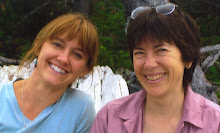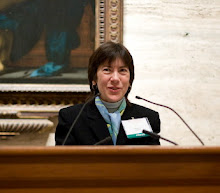I'm adding another facet to my career, and how it might fit under my byline is still evolving. Not long ago I signed up for an online nutrition course with the Global College of Natural Medicine. The program leads to certification in nutritional consulting, the goal being to make me more "expert" at providing information about food, eating and health (not that I haven't been doing this already! ask my family members, who for the last few decades have put up with my pronouncements about the virtues of B vitamins. As my sister Adrienne said when I told her I'd signed up for the program, "Duh, Kate! What took you so long?!").
The first assignment I took on within this self-paced curriculum is a Mini-Course called "Writing for Publication." Very fun to go back to beginner's mind and write from a new angle. Although, really, it's not totally new: I've done a little food writing in the past; writing about nutrition can fit neatly under the umbrella of science writing; and penning articles about holistic health dovetails nicely with environmental journalism, writing about nature and sustainability. So no matter how much I end up providing nutritional advice, I'll still be writing.
Right now I'm drafting a piece on cell phones and health, looking at how the close exposures to electromagnetic radiation from cell phone use might affect our needs for certain nutrients. A preliminary conclusion: I'm glad I never started using a cell phone. A link that can tell you more is at:
http://www.environmentaloncology.org/node/201
(University of Pittsburgh Cancer Center's concerns about cell phones, with ten precautionary recommendations)
Thursday, October 23, 2008
Friday, April 11, 2008
Water Wars
Growing up in northern California, I was not unfamiliar with water wars. My father told us tales about Owens Valley farmers who bombed the canals that later shipped water to Los Angeles from Owens Lake, draining it dry in 13 years. My grandfather, an impressionable teen from Sacramento at the time of the bombings, lived in California all his long life, but refused ever to set foot in water-grabbing L.A.
This introduced me to the volatility and complexity of water conflicts, a theme that former Newsweek reporter Peter Annin echoes in his excellent book, The Great Lakes Water Wars. Water tensions are on the rise, Annin writes. As demand for water outstrips supply in arid western North America, industrializing Asia, and other water-short regions, the Great Lakes will feel increasing pressure from proponents of diversions from this huge supply of the world's fresh surface water.
Water diversion projects have a history of disastrous results, as Annin illustrates by describing the fate of the shrunken Aral Sea. So Great Lakes decision makers have justification for making efforts to limit diversions, as they have done most recently with a Compact signed in 2005. With growing demand for water worldwide, will these efforts be enough to protect the Great Lakes? The stakes are high and it remains an open question, making Annin's book an important read for everyone in North America.
Ironically, the same Great Lakes water that many want for drinking also carries contaminants. That's pointed out by another important book about the Great Lakes that has worldwide implications: Melvin Visser's Cold, Clear and Deadly. This volume focuses on persistent organic pollutants (POPs), chlorinated chemicals now banned in the U.S. but still used in the developing world. POPs used anywhere can go airborne and travel the world; air circulation patterns carry them poleward, depositing them in cold water bodies like Lake Superior and the Arctic Ocean. From there, they move into the food chain and wreak biological havoc, disrupting reproduction as well as causing birth defects and neurological problems.
Visser's fascinating tale tells of his evolution from chemical engineer in the pharmaceutical industry -- he graduated from Michigan Tech and worked many years for Upjohn -- to an advocate of a complete global ban on the persistent organic pollutants with which he once worked. There's conflict and tension in Visser's book, too, as he writes about this other kind of "war" affecting the water supply: the debate over production and use of chlorinated chemicals.
These books came up in discussions last month at Michigan Tech as the campus celebrated World Water Day. As a lead-in, the student chapter of Engineers Without Borders held a Popcorn and Policy panel on Great Lakes Water issues. On World Water Day, March 24th, MTU hosted two excellent lectures, with Peter Annin discussing Great Lakes Water Wars, and Jay Austin from University of Minnesota, Duluth, who explained the recent finding of a surprisingly rapid rise in Lake Superior's surface temperature. The links in the right-hand column under "Lake Superior Basin Climate Change Series" include more about Austin's research.
This introduced me to the volatility and complexity of water conflicts, a theme that former Newsweek reporter Peter Annin echoes in his excellent book, The Great Lakes Water Wars. Water tensions are on the rise, Annin writes. As demand for water outstrips supply in arid western North America, industrializing Asia, and other water-short regions, the Great Lakes will feel increasing pressure from proponents of diversions from this huge supply of the world's fresh surface water.
Water diversion projects have a history of disastrous results, as Annin illustrates by describing the fate of the shrunken Aral Sea. So Great Lakes decision makers have justification for making efforts to limit diversions, as they have done most recently with a Compact signed in 2005. With growing demand for water worldwide, will these efforts be enough to protect the Great Lakes? The stakes are high and it remains an open question, making Annin's book an important read for everyone in North America.
Ironically, the same Great Lakes water that many want for drinking also carries contaminants. That's pointed out by another important book about the Great Lakes that has worldwide implications: Melvin Visser's Cold, Clear and Deadly. This volume focuses on persistent organic pollutants (POPs), chlorinated chemicals now banned in the U.S. but still used in the developing world. POPs used anywhere can go airborne and travel the world; air circulation patterns carry them poleward, depositing them in cold water bodies like Lake Superior and the Arctic Ocean. From there, they move into the food chain and wreak biological havoc, disrupting reproduction as well as causing birth defects and neurological problems.
Visser's fascinating tale tells of his evolution from chemical engineer in the pharmaceutical industry -- he graduated from Michigan Tech and worked many years for Upjohn -- to an advocate of a complete global ban on the persistent organic pollutants with which he once worked. There's conflict and tension in Visser's book, too, as he writes about this other kind of "war" affecting the water supply: the debate over production and use of chlorinated chemicals.
These books came up in discussions last month at Michigan Tech as the campus celebrated World Water Day. As a lead-in, the student chapter of Engineers Without Borders held a Popcorn and Policy panel on Great Lakes Water issues. On World Water Day, March 24th, MTU hosted two excellent lectures, with Peter Annin discussing Great Lakes Water Wars, and Jay Austin from University of Minnesota, Duluth, who explained the recent finding of a surprisingly rapid rise in Lake Superior's surface temperature. The links in the right-hand column under "Lake Superior Basin Climate Change Series" include more about Austin's research.
Sunday, March 9, 2008
A Little Background
Nature, environment, energy, food, wine, health, business, travel, and transportation: those are the topics I've been writing about since the late 1970s. My byline's appeared in a variety of periodicals including the Boston Globe, Keweenaw Now(online), Santa Rosa Press Democrat, Sonoma Index-Tribune, Upper Peninsula Post, E Magazine, Grist Magazine(online), Northern Lights, Orion Afield, Urban Ecologist, Utne Reader, Wild Earth, and others. I'm also the author of Divorce Your Car! Ending the Love Affair with the Automobile, and have published a smattering of poetry and short prose in west coast literary periodicals -- but the latter are topics for different blogs. This one features non-fiction, and ranges a bit into my teaching, speaking, and editing.
Lately, I've written a lot about climate -- and yes, global climate is changing. Check out my series on climate change in the Lake Superior basin, which won the 2007 Science Journalism Award for Online Reporting from the American Association for the Advancement of Science. The series appeared last spring and summer on the terrific local news site, www.KeweenawNow.com (now http://keweenawnow.blgspot.com). You'll find links to the three articles in the series on the right side of this page.
Lately, I've written a lot about climate -- and yes, global climate is changing. Check out my series on climate change in the Lake Superior basin, which won the 2007 Science Journalism Award for Online Reporting from the American Association for the Advancement of Science. The series appeared last spring and summer on the terrific local news site, www.KeweenawNow.com (now http://keweenawnow.blgspot.com). You'll find links to the three articles in the series on the right side of this page.
Subscribe to:
Posts (Atom)

